
Saturday, October 11, 2008
Saturday is Just Another Day on the Ship
Greetings from Canada, my son Nicky's favorite place! We are now in Canadian waters. We have crossed the international boarder. More amazing things keep coming up in our nets. Today we had some interesting sea-stars. Take a look.
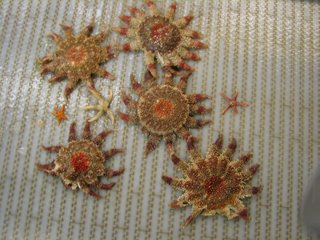
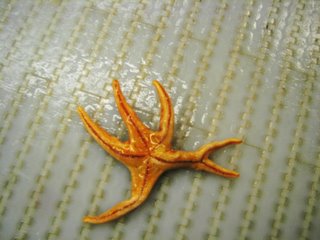
We had more dolphins circling the ship last night. We think our lights may be attracting certain fish or squid, then the dolphins come to eat that. They are not with us during the day at all. One of the benefits, I guess, of being on the night watch. I cannot shoot still photos due to the low light, but have wonderful video. The sounds that you hear on the video were recorded with the ship's hydrophone. This is a special microphone that can record sounds underwater. The sounds were recorded as the dolphins swam around the ship. You can hear the sound of them swimming by as well as the sound of their sonar as they locate fish to eat. Click here to watch and listen. Thanks to survey technician Pete Gamache for recording this for us. Click here to see the video. Don't miss it!
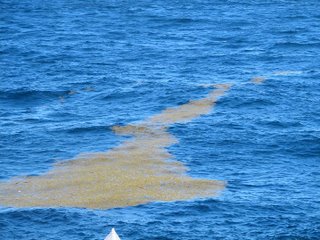
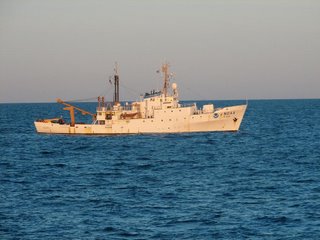
Our ship is shadowing another NOAA ship, the Albatross. Why? The Albatross is an old ship and will be replaced by the Bigelow in the years to come. At this point, the ships are trawling in exactly the same place to see if they get similar results in their surveys. Making sure the vessels measure the same thing the same way is called calibration. Right now we are doing calibration with the Albatross.
T – I love Block Island too. Thanks for the warning about rough seas. I am glad you and your mom are both enjoying the blog as much as I enjoy writing it for you. I'm used to the 12 AM shift now. I that I finally got 8 hours of sleep.
AR – There were TONS of skates in the water.
Hello to Mrs Eubank's Class. Its great to hear from you. Great questions. Now for answers:
-- Amanda, I think fish can get smaller pieces of plastic confused with tiny plankton, but our buoy is too large for that. I don't think it will hurt fish. I think they will stay away from it.
--Tiffany, this is a tough question and a very good question. I guess over time, our buoy will stop working and will become floating trash. The truth is all science effects the environment you study. The trick is to do more good with your work than harm. Our buoy will help us understand our environment better so that all of us will do less harm in the future. Our ship also burns fuel as we study the ocean. That pollutes a little, but hopefully through our work, we do more good than harm to what we study.
Weston, It felt like the drifter weighs about 35 pounds or so.
Bryce, we use a large net to scoop along the bottom. The opening is about 4 meters wide.
Luke, we have not, nor do I expect to find new species. Our purpose is to learn more about the species that we already know about.
Bryce, we were about 140 miles from the nearest land the last time I looked.
RJ, some scientists made our drifter.
Weston, there are about 1000 drifters right now in the open sea.
I enjoyed your questions. Thanks for writing.
Mr. Moretti's class, I'm not sure what killed the whale, but remember, all things the live also die. We cannot assume that something human beings did killed that whale. With all the pollution we create, we cannot assume, however, that we did not hurt it. We should stop polluting just to be sure we do not hurt other living things.
Many of you have are working hard to figure out our math question from the other day. Here is how it works. If we are going 8 knots for 24 hours, we multiply 8 times 24 and get 192 knots in a day. If we want to convert that to miles, we multiply again by 1.15 because each knot is 1.15 miles. We get 220.8 Congratulations to all who got this correct. It was a tough question.
Several of you have asked how long I would be on the ship. I will be here until the end of next week. I leave the ship on Friday October 17th.
LP – I enjoy the show Deadliest Catch very much. I think it is cool that scientists sometimes do that same kind of exciting work.
SD, there is no way for me to videotape under that water, but tomorrow I will show you how our sonars (we call them echosounders) work. That is one way to see under the water.
DT from SOMS dont' worry, there is no light pollution out here. I am on the back deck of a working ship, so right where I am there are lights. I need them to do my job. I just have to go to the upper decks to get away from it or ask the bridge to shut them down for a bit.
The larger ones are called Sun-Stars. Do they look like the sun to you? Sea stars are scavengers. They will move around the bottom looking for whatever food is laying around. The legs of the sea star have small tentacles that push food towards the mouth in the center.
Did you know that squid can change color? Often male squid change color to attract a mate or to scare off other males who are competing with them. If there are two males near one fema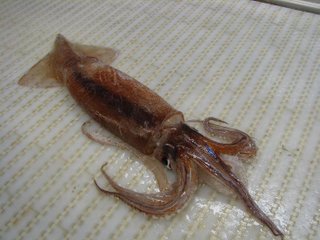 le, they able to turn one color on the side facing the female, and then turn another color on the other side facing the male. Check out this video of a squid changing color when I tickle it.
le, they able to turn one color on the side facing the female, and then turn another color on the other side facing the male. Check out this video of a squid changing color when I tickle it.
We had more dolphins circling the ship last night. We think our lights may be attracting certain fish or squid, then the dolphins come to eat that. They are not with us during the day at all. One of the benefits, I guess, of being on the night watch. I cannot shoot still photos due to the low light, but have wonderful video. The sounds that you hear on the video were recorded with the ship's hydrophone. This is a special microphone that can record sounds underwater. The sounds were recorded as the dolphins swam around the ship. You can hear the sound of them swimming by as well as the sound of their sonar as they locate fish to eat. Click here to watch and listen. Thanks to survey technician Pete Gamache for recording this for us. Click here to see the video. Don't miss it!
We drove past some seaweed called sargasum weed. It normally grows in an area towards the middle of the Atlantic called the Sargasso Sea. We are well west of the Sargasso, but this seems to have drifted our way. Sargasum Weed grows on the surface of the water. These huge mats of seaweed support an entire ecosystem of sea creatures. Many come to seek shelter in the weeds. Many more come to feed on smaller creatures hiding there. 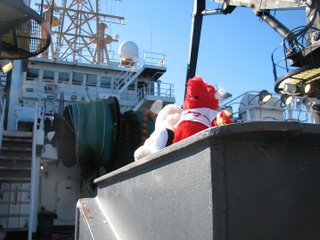
Snuggy and Zee paid a visit to the fantail of the ship. This is an area by the stern of the vessel where the nets are deployed. The photos show the area where the work gets done. Our ship works all night long, of course, and trawls are done at night as well as during the day. Take a look at this video which explains how trawls are done.
Our ship is shadowing another NOAA ship, the Albatross. Why? The Albatross is an old ship and will be replaced by the Bigelow in the years to come. At this point, the ships are trawling in exactly the same place to see if they get similar results in their surveys. Making sure the vessels measure the same thing the same way is called calibration. Right now we are doing calibration with the Albatross.
-----------------------------------------------------
Now some answers to your questions:
RM – No we did not see Nantucket yet. We were too far out to sea. We may see it on the way back. Thanks for writing.
Now some answers to your questions:
RM – No we did not see Nantucket yet. We were too far out to sea. We may see it on the way back. Thanks for writing.
T – I love Block Island too. Thanks for the warning about rough seas. I am glad you and your mom are both enjoying the blog as much as I enjoy writing it for you. I'm used to the 12 AM shift now. I that I finally got 8 hours of sleep.
AR – There were TONS of skates in the water.
Hello to Mrs Eubank's Class. Its great to hear from you. Great questions. Now for answers:
-- Amanda, I think fish can get smaller pieces of plastic confused with tiny plankton, but our buoy is too large for that. I don't think it will hurt fish. I think they will stay away from it.
--Tiffany, this is a tough question and a very good question. I guess over time, our buoy will stop working and will become floating trash. The truth is all science effects the environment you study. The trick is to do more good with your work than harm. Our buoy will help us understand our environment better so that all of us will do less harm in the future. Our ship also burns fuel as we study the ocean. That pollutes a little, but hopefully through our work, we do more good than harm to what we study.
Weston, It felt like the drifter weighs about 35 pounds or so.
Bryce, we use a large net to scoop along the bottom. The opening is about 4 meters wide.
Luke, we have not, nor do I expect to find new species. Our purpose is to learn more about the species that we already know about.
Bryce, we were about 140 miles from the nearest land the last time I looked.
RJ, some scientists made our drifter.
Weston, there are about 1000 drifters right now in the open sea.
I enjoyed your questions. Thanks for writing.
Mr. Moretti's class, I'm not sure what killed the whale, but remember, all things the live also die. We cannot assume that something human beings did killed that whale. With all the pollution we create, we cannot assume, however, that we did not hurt it. We should stop polluting just to be sure we do not hurt other living things.
Many of you have are working hard to figure out our math question from the other day. Here is how it works. If we are going 8 knots for 24 hours, we multiply 8 times 24 and get 192 knots in a day. If we want to convert that to miles, we multiply again by 1.15 because each knot is 1.15 miles. We get 220.8 Congratulations to all who got this correct. It was a tough question.
Several of you have asked how long I would be on the ship. I will be here until the end of next week. I leave the ship on Friday October 17th.
LP – I enjoy the show Deadliest Catch very much. I think it is cool that scientists sometimes do that same kind of exciting work.
SD, there is no way for me to videotape under that water, but tomorrow I will show you how our sonars (we call them echosounders) work. That is one way to see under the water.
DT from SOMS dont' worry, there is no light pollution out here. I am on the back deck of a working ship, so right where I am there are lights. I need them to do my job. I just have to go to the upper decks to get away from it or ask the bridge to shut them down for a bit.







